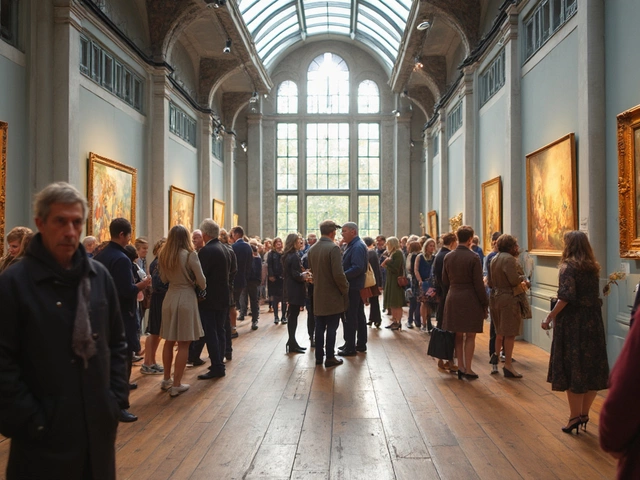Leonardo da Vinci’s masterpiece, the Mona Lisa, hangs serenely in the Louvre Museum in Paris, enchanting millions of visitors each year. For centuries, this enigmatic portrait has captivated the imagination of the world, inspiring countless interpretations and even a heist or two. But in a world where vast fortunes often make the improbable possible, one might wonder: Could a billionaire actually buy and own the Mona Lisa?
The question isn't as straightforward as it might seem. The Mona Lisa isn’t just an artwork; it's a cultural heritage symbol recognized globally. Moreover, it's technically state property, owned by the French government, which adds layers of complexity to any potential purchase scenario. To even consider its purchase, one must navigate a labyrinth of legal, ethical, and cultural issues, raising the stakes beyond a mere large transaction.
- The Ownership of the Mona Lisa
- Cultural Significance and Public Ownership
- How Art Transactions Work
- Challenges for Private Ownership
- The Role of Billionaires in the Art Market
The Ownership of the Mona Lisa
At first glance, the Mona Lisa might seem like just another painting among the numerous artworks housed in museums around the world. However, its story is woven deeply into the fabric of French national identity, making its ownership both an intriguing and complex matter. Originally painted by Leonardo da Vinci in the early 16th century for the wealthy merchant Francesco del Giocondo, it found its way into the hands of King Francis I after Leonardo's death and subsequently became property of the French Crown. This royal affiliation eventually transitioned into the custody of the French government during and after the French Revolution, cementing its status as a public treasure. Even today, the Mona Lisa is defined as French national property, protected by laws that keep it squarely within the public domain and, most importantly, within the walls of the Louvre Museum in Paris.
As it stands, the ownership of such an iconic masterpiece is not just about possession; it's about stewardship. The French have long considered the Mona Lisa a piece of their cultural heritage, one that cannot be disentangled from the public good it represents. In legal terms, the painting is classified as being part of France's public domain. Consequently, its ownership by the state is incontrovertible, and international art laws further ensconce its non-transferable status. The French government, reflecting societal sentiment, has made it explicitly clear that the painting is not for sale under any circumstances. This perspective aligns with Thomas Campbell, the former director of the Metropolitan Museum of Art, who noted,
"The Mona Lisa is beyond commercial value; it belongs to the people as a symbol of their shared history."
In recent years, the notion of billionaires acquiring significant works of art has sparked debates on the implications of private ownership. While many billionaires view art as an investment or status symbol that can be purchased and displayed privately, the Mona Lisa remains elusive to such buying power. French cultural policies stipulate that national treasures can never be alienated, and any attempts to move the painting into private hands would involve a labyrinth of bureaucratic hurdles, international outcry, and potential legal action. Technically speaking, even the wealthiest individuals find themselves tethered by the very laws that protect public artworks. Thus, while in theory the market might determine a price for nearly anything, the Mona Lisa transcends these limitations by its very definition as a national treasure.
Cultural Significance and Public Ownership
The Mona Lisa is more than just a portrait of a woman with an enigmatic smile; it is an integral piece of world culture and an indispensable part of France's national heritage. Conceived by Leonardo da Vinci during the Renaissance period, the painting represents a confluence of art, history, and human achievement that no monetary value can truly encapsulate. Owned by the French Republic, it reflects not just the skill of a master but also centuries of art history and serves as a symbol of peace and cultural convergence housed in the Louvre. The painting's presence in the public domain allows millions access to this masterpiece each year, fostering cultural appreciation and dialogue among diverse global audiences.
The importance of keeping the Mona Lisa in public ownership cannot be overstated. Publicly owned art serves as a unifying element that transcends social and economic divides, enabling people from all walks of life to engage with a piece of human history firsthand. Imagine if such works were hidden away in private collections accessible only to a select few? This exclusivity would mute the shared experiences that public art engenders, stalling social progress and diminishing the collective cultural wealth accessible to all of us. Public ownership ensures that artworks like the Mona Lisa stay venues for education and inspiration.
The specter of selling the Mona Lisa, even to the wealthiest of buyers, raises profound ethical and legal questions. Governments preserve these cultural treasures not only for their economies but also as guardians of global heritage. As the art historian Sir Kenneth Clark once observed,
"Great works of art should not be hidden away; they belong to everyone."This ethos underscores many nations' commitment to keep national treasures publicly accessible. Such policies are reinforced by international agreements, such as UNESCO conventions, which affirm the obligation to preserve cultural heritage worldwide. Any proposition to transfer possession to a private individual must surmount these deep-rooted legal and ethical barriers.
These conceptual obligations highlight how emergent this discussion becomes in a world where billionaires increasingly pour fortunes into art acquisitions. Wealth notwithstanding, the acquisition of a cultural icon like the Mona Lisa poses a fundamental challenge to how we view art markets and ownership paradigms. Some argue that private ownership can offer protection and individualized care, yet the loss of public access and the potential online divide is a detriment to cultural enrichment for the masses. Consequently, museums and public entities continue to champion the idea that art belongs in collective spaces where stories from past coalesce with present narratives, forming the cultural compass of our societies.
How Art Transactions Work
The world of art transactions can be as intricate as the brushstrokes on a da Vinci canvas, dominated by a mix of traditional practices, market dynamics, and the occasional splash of unpredictability. At its core, the art market can be segmented into two main places: galleries and auctions. Galleries are often less visible compared to their flamboyant counterparts, the auction houses like Sotheby’s and Christie’s, but they play a crucial role in the primary market where new works are sold directly for the first time.
Auction houses handle the secondary market, and it's here that art can fetch staggering amounts. Record-breaking sales, like the $450.3 million price tag for da Vinci’s "Salvator Mundi," captured international headlines and spiraled into discussions about market values and the hidden pressures that can inflate prices. These venues thrive on the drama of bidding wars, where emotions run high and fortunes swing by the flick of a paddle. The atmosphere can be electric, as collectors, investors, and dealers vie for treasures.
Authentication and Provenance
For any art transaction, especially at such high stakes, authenticity is paramount. Provenance—the history of a piece's ownership—must be meticulously documented. This is where issues can get thorny; stolen or looted artworks sometimes resurface, weaving a web of legal and ethical claims that can bog down a sale. Both buyers and sellers rely on experts to verify the artwork's originality, often employing high-tech tools like X-ray fluorescence or infrared reflectography to uncover what our eyes cannot see. Provenance documents, sometimes dating back centuries, are scrutinized alongside modern scientific analysis to assure potential owners of their investment's legitimacy.
The art market has seen fluctuations in how pieces are valued, often driven by subjective factors such as an artist's reputation, scarcity, and the current demand. For instance, the recent trend of contemporary art soaring in popularity has escalated prices dramatically for some living artists, creating new records previously unseen during the lifetimes of most artists.
"Value in the art world is a mix of historical narrative and modern myth," said Philip Hook, a senior specialist in the field.Collectors, be they billionaire magnates or seasoned investors, seek more than just aesthetic pleasure; they're looking at potential financial returns and cultural prestige that come with owning such pieces.
Challenges for Private Ownership
Acquiring the Mona Lisa involves more than a simple financial transaction, transcending into a realm of intricate legal frameworks and public sentiments. As a priceless masterpiece, its ownership poses unique challenges uncommon in other assets. Firstly, the Mona Lisa is classified as a national treasure. According to French patrimony laws, such items are inalienable, making legal sale to private entities nearly impossible. The painting is not merely an asset but a symbol of France's cultural identity, correlating to an irreversible loss if transferred to private hands. The legal hurdles are thus immense, requiring modifications in longstanding laws, which could potentially set worrying precedents for other cultural holdings.
Moreover, ethical concerns flood the conversation around private ownership of such an iconic piece. Concerns extend to public access and the preservation of shared cultural heritage. Art patronage has evolved, with museums acting as stewards for shared human history, ensuring universal accessibility rather than exclusivity. The Mona Lisa in a private collection could eliminate free access currently enjoyed by millions globally. Questions arise: Would the new owner ensure its safety and expert preservation indefinitely? The expectations of stewardship become heavier when balancing personal ownership against collective benefit.
Exploring how art transactions work reveals the exclusive nature and high stakes of the art market. Confidentiality and discretion are paramount, with transactions often intermediated by high-profile galleries and auction houses. Yet, none have ever dared to evaluate a price for such a culturally loaded item. Renowned art dealer Bendor Grosvenor once stated, "The monetization of our shared heritage diminishes us all," summarizing the ethical tightrope a billionaire must walk.
There's an interesting dynamic within the art market where even the wealthiest buyers might not wield complete influence. Unlike commodities, rare works like the Mona Lisa don’t circulate freely, riding on intrinsic artistic worth rather than market volatility. The art world thrives on relationships, reputation, and often qualitative values. Buyers of rare art won't find loyalty in currency alone; it's rapport and respect towards art that counts. An attempt to acquire the Mona Lisa privately challenges the fabric of this delicate ecosystem.
On practical grounds, ensuring the secure transfer and storage of such an invaluable piece carries its own set of intricacies. Any private owner must provide assurances for security, insurance, and specialized maintenance on par with public museum standards. These considerations not only spike the cost beyond the initial purchase but emphasize the full weight of commitment required. Billionaire or not, the new custodian must arguably match, if not surpass, the Louvre's current care, which could pose a logistical nightmare for even the most prepared collector.
The Role of Billionaires in the Art Market
As the world has witnessed the rise of billionaires, their impact on the art market has grown significantly. These high net worth individuals often regard art not only as a cultural investment but also an instrument of cultural influence. With their seemingly boundless financial resources, billionaires have the power to command high prices at auctions, sometimes even setting new records. The Mona Lisa, though publicly owned, still stands as a trophy many billionaires might daydream about, in part because owning such a piece elevates status and ensures a lasting legacy.
The influence of billionaires extends beyond their purchasing power. They are instrumental in shaping trends within the art market as their preferences often direct the focus of artists and galleries alike. Many billionaires also contribute to the art world through philanthropy, either by establishing personal museums, funding public exhibitions, or in some cases, donating substantial artworks to renowned institutions. Their involvement often drives the value and visibility of certain artists or styles, effectively setting benchmarks that the market follows. However, such influence doesn’t come without criticism. Skeptics argue that it may skew the art world's creativity and authenticity.
One must also consider the ethical debate surrounding their influence. Aspiring collectors and art enthusiasts often struggle to compete in a market driven by the financial might of billionaires. This can lead to the exclusion of valuable art from public access, as many notable pieces end up in private collections. A staggering instance occurred when Leonardo's "Salvator Mundi" sold for $450.3 million, creating a buzz and raising eyebrows about the moral aspects of art accessibility.
"In some ways, it’s inspiring to see these works of art achieve such high statuses; in others, it locks them away from the public eye," says a prominent art critique from The Guardian.Nevertheless, it's undeniable that without them, the market might lack the vibrant dynamism we see today.
The economic impact of billionaires extends beyond galleries and auction houses. Secondary markets and small collectors keenly feel the ripples of their high-profile investments. As works of art appreciate in value due to high demand, art insurance, estate planning, and wealth management sectors also experience expansions. Whether it’s unintended or deliberate, billionaires create a broader economic ecosystem revolving around the art they amass. This intricate interplay between financial behemoths and the art world continues to drive an ever-evolving dialogue.
Considering this substantial influence, it's crucial to recognize both the opportunities and challenges billionaires present to the art market. While their substantial monetary input can fuel creativity and preservation, it also necessitates a cautious balancing act to ensure arts remain accessible to the general public. By understanding and addressing these dynamics, a more inclusive art world might just be possible. Billionaires in the art market are not just patrons but transformative players, with all the complexities their presence entails.




